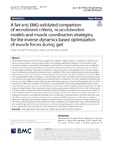Mostrar o rexistro simple do ítem
A Fair and EMG‑Validated Comparison of Recruitment Criteria, Musculotendon Models and Muscle Coordination Strategies, for the Inverse‑Dynamics Based Optimization of Muscle Forces During Gait
| dc.contributor.author | Michaud, Florian | |
| dc.contributor.author | Lamas, Mario | |
| dc.contributor.author | Lugrís-Armesto, Urbano | |
| dc.contributor.author | Cuadrado, Javier | |
| dc.date.accessioned | 2021-03-16T18:33:47Z | |
| dc.date.available | 2021-03-16T18:33:47Z | |
| dc.date.issued | 2021-01 | |
| dc.identifier.citation | Michaud, F., Lamas, M., Lugrís, U. et al. A fair and EMG-validated comparison of recruitment criteria, musculotendon models and muscle coordination strategies, for the inverse-dynamics based optimization of muscle forces during gait. J NeuroEngineering Rehabil 18, 17 (2021). https://doi.org/10.1186/s12984-021-00806-6 | |
| dc.identifier.issn | 1743-0003 | |
| dc.identifier.uri | http://hdl.handle.net/2183/27542 | |
| dc.description.abstract | [Abstract] Experimental studies and EMG collections suggest that a specific strategy of muscle coordination is chosen by the central nervous system to perform a given motor task. A popular mathematical approach for solving the muscle recruitment problem is optimization. Optimization-based methods minimize or maximize some criterion (objective function or cost function) which reflects the mechanism used by the central nervous system to recruit muscles for the movement considered. The proper cost function is not known a priori, so the adequacy of the chosen function must be validated according to the obtained results. In addition of the many criteria proposed, several physiological representations of the musculotendon actuator dynamics (that prescribe constraints for the forces) along with different musculoskeletal models can be found in the literature, which hinders the selection of the best neuromusculotendon model for each application. Seeking to provide a fair base for comparison, this study measures the efficiency and accuracy of: (i) four different criteria within the static optimization approach (where the physiological character of the muscle, which affects the constraints of the forces, is not considered); (ii) three physiological representations of the musculotendon actuator dynamics: activation dynamics with elastic tendon, simplified activation dynamics with rigid tendon and rigid tendon without activation dynamics; (iii) a synergy-based method; all of them within the framework of inverse-dynamics based optimization. Motion/force/EMG gait analyses were performed on ten healthy subjects. A musculoskeletal model of the right leg actuated by 43 Hill-type muscles was scaled to each subject and used to calculate joint moments, musculotendon kinematics and moment arms. Muscle activations were then estimated using the different approaches, and these estimates were compared with EMG measurements. Although no significant differences were obtained with all the methods at statistical level, it must be pointed out that a higher complexity of the method does not guarantee better results, as the best correlations with experimental values were obtained with two simplified approaches: the static optimization and the physiological approach with simplified activation dynamics and rigid tendon, both using the sum of the squares of muscle forces as objective function. | es_ES |
| dc.description.sponsorship | This work was funded by the Spanish MICIU under project PGC2018-095145-B-I00, co-financed by the EU through the EFRD program, and by the Galician Government under grant ED431C2019/29. Moreover, F. Michaud would like to acknowledge the support of the Spanish MINECO by means of the doctoral research contract BES-2016–076901, co-financed by the EU through the ESF program | es_ES |
| dc.description.sponsorship | Xunta de Galicia; ED431C2019/29 | |
| dc.language.iso | eng | es_ES |
| dc.publisher | BioMed Central Ltd. | es_ES |
| dc.relation | info:eu-repo/grantAgreement/AEI/Plan Estatal de Investigación Científica y Técnica y de Innovación 2017-2020/PGC2018-095145-B-I00/ES/ESTUDIO DE LA RELACION ENTRE EFICIENCIA Y NIVEL DE DETALLE EN MODELOS BIOMECANICOS DEL CUERPO HUMANO | |
| dc.relation | info:eu-repo/grantAgreement/AEI/Plan Estatal de Investigación Científica y Técnica y de Innovación 2013-2016/BES-2016–076901/ES/ | |
| dc.relation.uri | https://doi.org/10.1186/s12984-021-00806-6 | es_ES |
| dc.rights | Atribución 4.0 Internacional | es_ES |
| dc.rights.uri | http://creativecommons.org/licenses/by/4.0/ | * |
| dc.subject | Static optimization | es_ES |
| dc.subject | Musculotendon models | es_ES |
| dc.subject | Gait | es_ES |
| dc.subject | Muscle forces | es_ES |
| dc.subject | EMG validation | es_ES |
| dc.title | A Fair and EMG‑Validated Comparison of Recruitment Criteria, Musculotendon Models and Muscle Coordination Strategies, for the Inverse‑Dynamics Based Optimization of Muscle Forces During Gait | es_ES |
| dc.type | info:eu-repo/semantics/article | es_ES |
| dc.rights.access | info:eu-repo/semantics/openAccess | es_ES |
| UDC.journalTitle | Journal of NeuroEngineering and Rehabilitation | es_ES |
| UDC.volume | 18 | es_ES |
| UDC.issue | 17 | es_ES |
| dc.identifier.doi | 10.1186/s12984-021-00806-6 |
Ficheiros no ítem
Este ítem aparece na(s) seguinte(s) colección(s)
-
LIM - Artigos [43]






